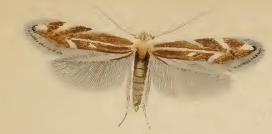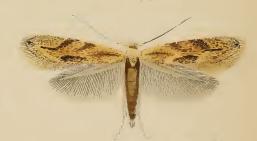
Bucculatrix canadensisella, the birch skeletonizer, is a moth of the family Bucculatricidae. The species was first described by Vactor Tousey Chambers in 1875. It is found in North America. In Canada, it has been recorded from New Brunswick to British Columbia, Nova Scotia and Prince Edward Island. In the United States, it has been recorded from New York, New Jersey, Michigan, Wisconsin, Minnesota, Pennsylvania, North Carolina, Tennessee, Kentucky and Colorado.
Bucculatrix parthenica is a moth of the family Bucculatricidae. It is native to Mexico, but was released in Queensland, Australia, as a biological control agent for Parthenium weeds. It was described by John David Bradley in 1990.

Bucculatrix maritima is a species of moth of the family Bucculatricidae. It is found in most of Europe, Russia and Japan. It was first described in 1851 by Henry Tibbats Stainton.

Bucculatrix bechsteinella is a moth of the family Bucculatricidae. It was described by Johann Matthäus Bechstein and Georg Ludwig Scharfenberg in 1805. It is found in most of Europe, except Greece and Bulgaria.
Bucculatrix agnella is a species of moth in the family Bucculatricidae. The species was first described by James Brackenridge Clemens in 1860. It is found in North America, where it has been recorded in Pennsylvania, New Jersey, New York, Washington D.C., Massachusetts, Indiana, Tennessee, Kentucky, Michigan, Missouri, South Dakota, Maine, Ohio and Texas.
Bucculatrix ambrosiaefoliella is a species of moth in the family Bucculatricidae. It is found in North America, where it has been recorded from California, Texas, Arizona, Pennsylvania, Kentucky, Missouri, Iowa, Maine and Ohio. The species was first described by Vactor Tousey Chambers in 1875.
Bucculatrix solidaginiella is a species of moth in the family Bucculatricidae. It is found in North America, where it has been recorded from Florida, Louisiana, Maine, Missouri, New Jersey, Mississippi and Ohio. It was described in 1963 by Annette Frances Braun.
Bucculatrix simulans is a moth in the family Bucculatricidae. It is found in North America, where it has been recorded from Texas to Iowa and Ohio. It was described in 1963 by Annette Frances Braun.
Bucculatrix seneciensis is a moth in the family Bucculatricidae. It is found in North America, where it has been recorded from California. It was described by Annette Frances Braun in 1963.
Bucculatrix pallidula is a species of moth in the family Bucculatricidae. It is found in North America, where it has been recorded from Maine and Utah. It was described in 1963 by Annette Frances Braun.
Bucculatrix eupatoriella is a moth in the family Bucculatricidae. It is found in North America, where it has been recorded from Ohio and North Carolina. It was described in 1918 by Annette Frances Braun.
Bucculatrix speciosa is a moth in the family Bucculatricidae. It is found in North America, where it has been recorded from Indiana and West Virginia. It was first described in 1963 by Annette Frances Braun.
Bucculatrix arnicella is a species of moth in the family Bucculatricidae. The species was first described in 1925 by Annette Frances Braun. It is found in North America, where it has been recorded from Utah, Montana, Alberta and Wyoming. The habitat consists of open lodgepole pine and Douglas fir forests.
Bucculatrix packardella is a moth in the family Bucculatricidae. It was described by Vactor Tousey Chambers in 1873. It is found in North America, where it has been recorded from Ohio, Maine, Michigan, Ontario, Pennsylvania, Washington D.C., Delaware, New Jersey, New York and Rhode Island.
Bucculatrix improvisa is a moth in the family Bucculatricidae. It was described by Annette Frances Braun in 1963 and is found in North America, where it has been recorded from Ohio.
Bucculatrix recognita is a moth in the family Bucculatricidae. It was described by Annette Frances Braun in 1963 and is found in North America, where it has been recorded from Ontario, Maine, New Hampshire, Massachusetts, Missouri, New Jersey, Washington, D.C., North Carolina and South Carolina.
Bucculatrix locuples is a moth in the family Bucculatricidae. It was described in 1919 by Edward Meyrick. It is found in North America, where it has been recorded from Kentucky, Quebec and Ohio.
Bucculatrix ceanothiella is a moth in the family Bucculatricidae. The species was first described in 1918 by Annette Frances Braun. It is found in North America, where it has been recorded from California.
Bucculatrix pomifoliella is a moth in the family Bucculatricidae. It was described by James Brackenridge Clemens in 1860 and is found in North America, where it has been recorded from Pennsylvania, Virginia, New Jersey, New York, Massachusetts, Maine, Ontario, Ohio, Tennessee, North Carolina, Missouri, Utah, Washington, British Columbia, Indiana, Manitoba, Quebec and West Virginia.
Bucculatrix quadrigemina is a moth in the family Bucculatricidae. It was described in 1918 by Annette Frances Braun and is found in North America, where it has been recorded from California.
